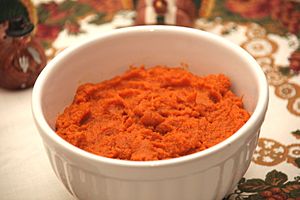Mashed pumpkin facts for kids
Mashed pumpkin is a yummy vegetable dish made from the soft inside part of a pumpkin. To make it, you cook the pumpkin flesh (the orange part) and then mash it until it's smooth. It's often served as a side dish with meals, but you can also use it in many different recipes for cooking and baking.
History
Pumpkins first grew in North America and South America. Long ago, Native Americans grew and ate a lot of pumpkin. Many tribes on the eastern coast of North America enjoyed mashed pumpkin.
Some Native Americans even used mashed pumpkin on cuts and scrapes, like a soft paste, to help them heal. It's thought that mashed pumpkin was probably served at the famous 1621 "First Thanksgiving" celebration. This event happened at Plymouth Colony in America, where members of the Wampanoag tribe shared a harvest festival with the Pilgrims.
When English colonists came to New England, they quickly started eating pumpkin too. "Pumpkin sauce," which was mashed pumpkin, was served at inns (like small hotels) in New England as early as 1704. People also added mashed pumpkin to breads and cakes to give them flavor and make them sweeter. By the mid-1700s, mashed pumpkin was also used to make pies. In the Dutch colony of New Amsterdam (which is now New York City), people mixed mashed pumpkin with corn meal and fried it like a pancake.
How It's Made
Chefs usually suggest steaming pumpkin when you want to make mashed pumpkin. Boiling pumpkin in water can make its flavor much weaker. Some chefs prefer fried or roasted pumpkin because they feel it has a stronger taste than mashed pumpkin.
However, well-seasoned mashed pumpkin tastes great with cooked game birds like quail. In New England, a common side dish is mashed pumpkin sweetened with dark maple syrup, served with roast chicken or baked ham. Mashed pumpkin can also be used in many bread and cake recipes instead of fat.
Why It's Good For You
A single cup of plain mashed pumpkin has only 49 calories. But it's packed with good things for your body! It has 564 mg of potassium, which is good for your muscles and nerves.
It also has lots of special nutrients called carotenoids, like 5,000 mcg of beta-carotene, 853 mcg of alpha-carotene, and 3,500 mcg of beta-cryptoxanthin. These are the things that give pumpkins their bright orange color and are very important because your body turns them into vitamin A. Mashed pumpkin has a huge 12,000 IUs of vitamin A, which is great for your eyesight and immune system. It also has 2,400 mcg of lutein and zeaxanthin, which are good for your eyes. Plus, it has 2.5 g of dietary fiber, which helps your digestion.


